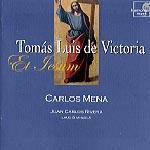Listeners will be both surprised and enthralled by the music and performances on this extraordinary recording: surprised to find that such transcriptions for solo voice and vihuela or lute exist of these magnificent works, known for centuries in their choral settings, and enthralled by the sheer beauty, sensitivity, and sensuousness of the performances. The catch is, most of what we hear are adaptations by the performers–not by Victoria himself or any of his contemporaries or immediate followers–that are nevertheless in keeping with a common practice during Victoria’s time and after. Taking their models (and a few actual selections) from several 16th and 17th-century manuscripts that feature dozens of vocal works–by such composers as Victoria, Byrd, Tallis, Marenzio, and Palestrina–transcribed for plucked-string instruments and voice, Juan Carlos Rivera and countertenor Carlos Mena added self-made transcriptions of their own favorite Victoria works to create a musically engaging, eminently listenable program. (I should mention that it takes some effort, and a little knowledge of Spanish, to determine exactly which selections come from which sources, and in the case of the original-manuscript pieces, there’s no way to tell how precisely they were followed. Providing such basic information would have been easy and helpful for interested listeners.)
For anyone who may have doubts concerning the usefulness of these kinds of transcriptions, or who may think the results will be unimpressive relative to Victoria’s original choral works–throw away your worries. These renditions, beautifully sung and artfully played by Mena and Rivera (and on a couple of pieces, by cornetist Francisco Gallego) preserve all of the music’s harmonic elements and much of the original polyphonic activity while focusing our ear even more attentively on Victoria’s lovely, lyrical melodic lines and on the texts that inspired them. It’s a pleasure to hear the beloved motet O magnum mysterium in this setting, and although Mena necessarily sings only the upper-most voice part, he proves it more than worthy of its role as a stand-alone melody. Other highlights are the motets Ne timeas, Maria and Iste Sanctus, where Mena sings with an ardor and technical mastery that brings us directly to the music’s emotional core. Several tracks feature Rivera alone in his own thoughtfully and skillfully rendered instrumental transcriptions of three mass movements; he joins with Mena for three more, this time from the Missa O magnum mysterium. In all, this is a classy, unique, and very affecting program that gives a welcome perspective on works we may know well–but, as we discover here, not well enough. The sound is first-rate. Highly recommended. [5/10/2004]
































